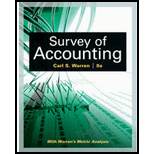
Concept explainers
Concept Introduction:
NPV:
To Calculate:
The Net Present Value for each project
Answer to Problem 15.4.1P
The Net Present value for each project for each project is as follows:
| Net Present Value | |
| Radio Station | $ 176,325 |
| TV Station | $ 148,809 |
Explanation of Solution
The Net Present value for each project is calculated as follows:
| Radio Station | Amount | PVF (10%) | PV |
| A | B | =A*B | |
| Annual Net Cash Flows | |||
| Year 1 | $ 560,000 | 0.90909 | $ 509,091 |
| Year 2 | $ 560,000 | 0.82645 | $ 462,810 |
| Year 3 | $ 560,000 | 0.75131 | $ 420,736 |
| Year 4 | $ 560,000 | 0.68301 | $ 382,488 |
| Present Value of | $ 1,775,125 | ||
| Investment (B) | $ 1,598,800 | 1.00000 | $ 1,598,800 |
| Net Present Value (A-B) | $ 176,325 | ||
| TV Station | Amount | PVF (20%) | PV |
| A | B | =A*B | |
| Annual Net Cash Flows | |||
| Year 1 | $ 1,120,000 | 0.90909 | $ 1,018,182 |
| Year 2 | $ 1,120,000 | 0.82645 | $ 925,620 |
| Year 3 | $ 1,120,000 | 0.75131 | $ 841,473 |
| Year 4 | $ 1,120,000 | 0.68301 | $ 764,975 |
| Present Value of Cash Inflow (A) | $ 3,550,249 | ||
| Investment (B) | $ 3,401,440 | 1.00000 | $ 3,401,440 |
| Net Present Value (A-B) | $ 148,809 |
Concept Introduction:
NPV:
Net present value (NPV) is the method to evaluate the project feasibility. This method calculates the present value of cash inflows and outflows, and then calculates the net present value of the investment. A project should be accepted if it has a positive NPV. The formula to calculate the NPV is as follows:
To Calculate:
The Present Value Index for each project
Answer to Problem 15.4.1P
The Present Value Index for each project is as follows:
| Present Value Index | |
| Radio Station | 1.11 |
| TV Station | 1.04 |
Explanation of Solution
The Present Value Index for each project is calculated as follows:
| Radio Station | Amount | PVF (10%) | PV |
| A | B | =A*B | |
| Annual Net Cash Flows | |||
| Year 1 | $ 560,000 | 0.90909 | $ 509,091 |
| Year 2 | $ 560,000 | 0.82645 | $ 462,810 |
| Year 3 | $ 560,000 | 0.75131 | $ 420,736 |
| Year 4 | $ 560,000 | 0.68301 | $ 382,488 |
| Present Value of Cash Inflow (A) | $ 1,775,125 | ||
| Investment (B) | $ 1,598,800 | 1.00000 | $ 1,598,800 |
| Present Value Index (A/B) | 1.11 | ||
| TV Station | Amount | PVF (20%) | PV |
| A | B | =A*B | |
| Annual Net Cash Flows | |||
| Year 1 | $ 1,120,000 | 0.90909 | $ 1,018,182 |
| Year 2 | $ 1,120,000 | 0.82645 | $ 925,620 |
| Year 3 | $ 1,120,000 | 0.75131 | $ 841,473 |
| Year 4 | $ 1,120,000 | 0.68301 | $ 764,975 |
| Present Value of Cash Inflow (A) | $ 3,550,249 | ||
| Investment (B) | $ 3,401,440 | 1.00000 | $ 3,401,440 |
| Present Value Index (A/B) | 1.04 |
Want to see more full solutions like this?
Chapter 15 Solutions
CengageNOWv2, 1 term Printed Access Card for Warren's Survey of Accounting, 8th
- I want to correct answer general accounting questionarrow_forwardHere are comparative balance sheets for Concord Company. CONCORD COMPANY Comparative Balance Sheets December 31 Assets 2022 2021 Cash $81,760 $24,640 Accounts receivable 97,440 85,120 Inventories 190,400 213,920 Land 80,640 112,000 Equipment 291,200 224,000 Accumulated depreciation (73,920) (35,840) Total $667,520 $623,840 Liabilities and Stockholders' Equity Accounts payable $41,440 $52,640 Bonds payable 168,000 235,200 Common stock ($1 par) 241,920 194,880 Retained earnings 216,160 141,120 Total $667,520 $623,840 Additional information: 1. Net income for 2022 was $112,000. 2. Cash dividends of $36,960 were declared and paid. 3. Bonds payable amounting to $67,200 were redeemed for cash $67,200. 4. Common stock was issued for $47,040 cash. 5. Equipment that cost $56,000 and had a book value of $33,600 was sold for $40,320 during 2022; land was sold at cost.arrow_forwardSolve this Accounting problemarrow_forward
 Managerial AccountingAccountingISBN:9781337912020Author:Carl Warren, Ph.d. Cma William B. TaylerPublisher:South-Western College Pub
Managerial AccountingAccountingISBN:9781337912020Author:Carl Warren, Ph.d. Cma William B. TaylerPublisher:South-Western College Pub Financial And Managerial AccountingAccountingISBN:9781337902663Author:WARREN, Carl S.Publisher:Cengage Learning,
Financial And Managerial AccountingAccountingISBN:9781337902663Author:WARREN, Carl S.Publisher:Cengage Learning, Intermediate Financial Management (MindTap Course...FinanceISBN:9781337395083Author:Eugene F. Brigham, Phillip R. DavesPublisher:Cengage LearningPrinciples of Accounting Volume 2AccountingISBN:9781947172609Author:OpenStaxPublisher:OpenStax College
Intermediate Financial Management (MindTap Course...FinanceISBN:9781337395083Author:Eugene F. Brigham, Phillip R. DavesPublisher:Cengage LearningPrinciples of Accounting Volume 2AccountingISBN:9781947172609Author:OpenStaxPublisher:OpenStax College EBK CONTEMPORARY FINANCIAL MANAGEMENTFinanceISBN:9781337514835Author:MOYERPublisher:CENGAGE LEARNING - CONSIGNMENT
EBK CONTEMPORARY FINANCIAL MANAGEMENTFinanceISBN:9781337514835Author:MOYERPublisher:CENGAGE LEARNING - CONSIGNMENT





